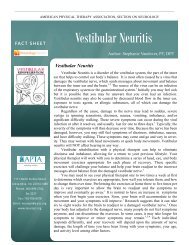Practice Guidelines for BPPV - Neurology Section
Practice Guidelines for BPPV - Neurology Section
Practice Guidelines for BPPV - Neurology Section
You also want an ePaper? Increase the reach of your titles
YUMPU automatically turns print PDFs into web optimized ePapers that Google loves.
Vestibular SIG Newsletter <strong>BPPV</strong> Special Edition<br />
Conclusions:<br />
Identifying side of involvement in HC <strong>BPPV</strong> is an<br />
essential diagnostic component to assist in selecting<br />
appropriate CRM interventions. This article reviewed<br />
four additional signs and positional tests that may help<br />
physical therapists identify side of involvement when<br />
combined with the SRT. The consistency at which<br />
spontaneous nystagmus, the BLT, SST has been<br />
described by different clinical research groups warrants<br />
adoption of these tests in to physical therapists’<br />
repertoire. Therapist should be encouraged to keep<br />
reading this literature, which provides very good<br />
depictions of the methods <strong>for</strong> implementing the tests and<br />
the underlying otoconia influences on the system and<br />
how they related to the presentation of nystagmus during<br />
the testing positions. Although the best combination of<br />
tests <strong>for</strong> the least amount of provocation has not been<br />
fully established, physical therapists should enhance<br />
their knowledge and skill in applying these tests to<br />
increase their diagnostic capability. Therapists should<br />
have the flexibility to add these tests as needed to<br />
accommodate different patient presentations of HC<br />
<strong>BPPV</strong>.<br />
References:<br />
1. Califano L, Melillo MG, Mazzone S, Vassallo<br />
A. "Secondary signs of lateralization" in<br />
apogeotropic lateral canalolithiasis. Acta<br />
Otorhinolaryngol Ital. 2010; 30(2):78-86.<br />
2. Lee JB, Han DH, Choi SJ, Park K, Park<br />
HY, Sohn IK, Choung YH. Efficacy of the "bow<br />
and lean test" <strong>for</strong> the management of horizontal<br />
canal benign paroxysmal positional<br />
vertigo. Laryngoscope. 2010, 120(11):2339-46.<br />
3. Lee SH, Choi KD, Jeong SH, Oh YM, Koo<br />
JW, Kim JS. Nystagmus during neck flexion in<br />
the pitch plane in benign paroxysmal positional<br />
vertigo involving the horizontal canal. J Neurol<br />
Sci. 2007;256(1-2):75-80.<br />
4. Han BI, Oh HJ, Kim JS. Nystagmus while<br />
recumbent in horizontal canal benign<br />
paroxysmal positional vertigo. <strong>Neurology</strong>. 2006<br />
66(5):706-10.<br />
5. Vestibular Rehabilitation Special Interest Group.<br />
The basics and beyond: what should entry-level<br />
education be <strong>for</strong> vestibular rehabilitation.<br />
14<br />
<strong>Neurology</strong> <strong>Section</strong> of APTA: CSM Round table.<br />
2003; http://www.neuropt.org/go/special-interestgroups/vestibular-rehabilitation/resources:<br />
Accessed 5/17/2012.<br />
6. Herdman S J, Tusa RJ. Physical therapy<br />
management of benign positional vertigo, In S. J.<br />
Herdman (ed.) Vestibular Rehabilitation, 3 rd<br />
edition, Philadelphia, F.A. Davis. 2007.<br />
7. Bhattacharyya N, Baugh RF, Orvidas L, et al.<br />
Clinical practice guideline: Benign paroxysmal<br />
positional vertigo. Otolaryngol Head Neck Surg.<br />
2008; 139; S47-S81.<br />
8. Bisdorff AR, Debatisse D. Localizing signs in<br />
positional vertigo due to lateral canal<br />
cupulolithiasis. <strong>Neurology</strong>. 2001;57:1085–1088<br />
9. De Stafano A, Kulmarva G, Citraro L. Neri G,<br />
Croce A. Spontaneous nystagmus in benign<br />
paroxysmal positional vertigo. A J Otolaryng Head<br />
Neck Med Surg. 2011; 32:185–189<br />
10. Jackson LE, Morgan B, Fletcher JC, Krueger<br />
WWO. Anterior canal benign paroxysmal<br />
positional vertigo: an under appreciated entity.<br />
Otology & Neurotology. 2007; 28:218-222.<br />
11. Dlugaiczyk J, Siebert S, Hecker D J, Brase C,<br />
Schick B. Involvement of the Anterior Semicircular<br />
Canal in Posttraumatic Benign Paroxysmal<br />
Positioning Vertigo. Otology & Neurotology. 2011;<br />
32:1285-1290.<br />
12. Nuti D, Mandalà M, Salerni L. Lateral canal<br />
paroxysmal positional vertigo revisited. Annals of<br />
the New York Academy of Sciences. 2009;<br />
1164:316-323.<br />
13. Asprella Libonati GA. Pseudo-Spontaneous<br />
Nystagmus: a new sign to diagnose the affected<br />
side in Lateral Semicircular Canal Benign<br />
Paroxysmal Positional Vertigo, Acta<br />
Otorhynolarynol Ital. 2008; 28:73-78.<br />
14. Choung Y-H, Shin YR, Kahng H, Park K, Choi SJ.<br />
‘Bow and Lean Test’ to determine the affected ear<br />
of horizontal canal benign paroxysmal positional<br />
vertigo. Laryngoscope. 2006; 116:1776–1781.<br />
15. Asprella Libonati GA. Diagnostic and treatment<br />
strategy of Lateral Semicircular Canal<br />
Canalolithiasis. Acta Otorhynolarynol Ital. 2005;<br />
25: 277-283.

















